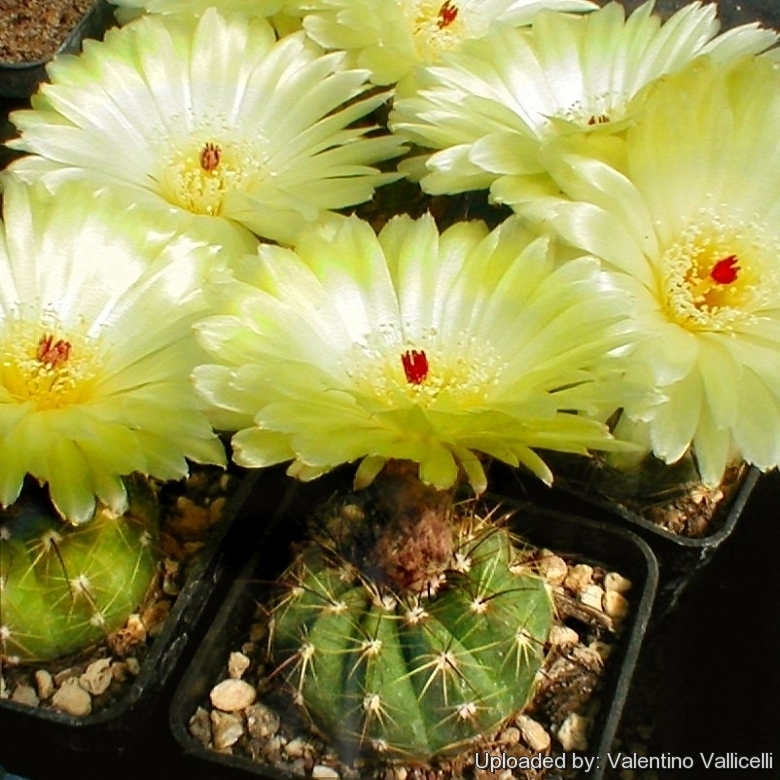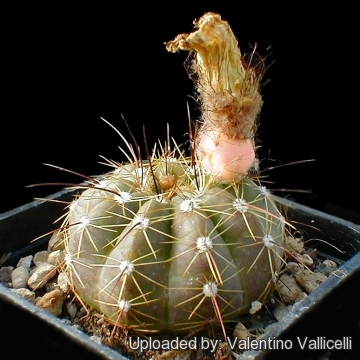Accepted Scientific Name: Parodia oxycostata (Buining & Bredero) Hofacker
Cactaceae Consensus Init. 6: 12. 1998

Notocactus glaucinus Photo by: Valentino Vallicelli
Origin and Habitat: Rio Grande do Sul, Brazil (Southern South America)
Habitat: It grows mostly on rocky outcrops and stony fields, in grasslands or pampas.
Synonyms:
See all synonyms of Parodia oxycostata
back
Accepted name in llifle Database:Parodia oxycostata (Buining & Bredero) HofackerCactaceae Consensus Init. 6: 12. 1998Synonymy: 20
Accepted name in llifle Database:Parodia oxycostata subs. gracilis (F.Ritter) HofackerCactaceae (Backeberg) 6: 12. 1998Synonymy: 4
back
Description: Parodia oxycostataSN|20466]]glaucina|SN|20473]] (a.k.a. Notocactus glaucinusSN|20473]]SN|20473]]) is a local form of the wide ranging and very variable Parodia oxycostataSN|20466]]SN|20466]] distinguished from the latter by the waxy coating on the epidermis (From Latin "glaucinus" = "With a waxy bloom") and pink fruits. The differences with other Parodia oxycostataSN|20466]]SN|20466]] are in reality very minimal and most botanist agree on the fact that both should all be included in the Parodia oxycostataSN|20466]], and the two plants are not readily distinguishable, if not for the geographical provenance. The "glaucina" is merely one of the several forms regarded as a mere ecotype with size or colour modified by more humid or arid conditions and merging into typical plants in cultivation. However similar plants occurs at random elsewhere.
Habit: Plants solitary, only rarely offsetting into small clusters in time. The stems are flattened globular and will bear several glossy yellow flowers around the very woolly stem apex in mid summer.
Stem: Flattened globose to globose, grey-green, to 9 cm in diameter.
Ribs: 6-12, acute, with shallow chinlike protrusions between the areoles.
Areoles: Round, white at first, later grey, then naked.
Spines: Reddish brown to bright yellow, becoming lighter with age, flattened, twisted.
Central spine: 1, pointing downward, upto 20 mm long.
Radial spines: Usually only 2, one pointing downward, 16-25 mm long, sometimes with as many as 8 additional small spines to 6 mm long.
Flowers: Borne several at a time apically, bell-fummel-shaped to sometimes urn shaped, yellow, to 1 cm long and 4,5 cm in diameter; pericarpels and floral tubes with scales, white wool, and reddish brown bristles in clusters. Stigma red.
Blooming season: Flowering occurs in summer through early fall and will bloom several times during warm weather.
Fruits: With yellowish grey wool and reddish brown bristles, 2,5-2,7 cm long.
Seeds: Helmet shaped, shiny black.
Subspecies, varieties, forms and cultivars of plants belonging to the Parodia oxycostata group
 Notocactus glaucinus F.Ritter: has a waxy bluish coating on the epidermis. Distribution: Rio Grande do Sul, Brazil.
Notocactus glaucinus F.Ritter: has a waxy bluish coating on the epidermis. Distribution: Rio Grande do Sul, Brazil. Notocactus glaucinus var. depressus F.Ritter: has flat light green stem and pink fruits. Distribution: Sao Francisco de Assis, Rio Grande do Sul, Brazil.
Notocactus glaucinus var. depressus F.Ritter: has flat light green stem and pink fruits. Distribution: Sao Francisco de Assis, Rio Grande do Sul, Brazil. Notocactus oxycostatus var. occidentalis N.Gerloff: has flattened spherical stems, 20-50 mm tall and 30-60 mm wide with ca. 7 ribs. Radial spines 5-7. Central spine 1. Distribution: Central Paraguay (Cordillera, Paraguarí and Missiones).
Notocactus oxycostatus var. occidentalis N.Gerloff: has flattened spherical stems, 20-50 mm tall and 30-60 mm wide with ca. 7 ribs. Radial spines 5-7. Central spine 1. Distribution: Central Paraguay (Cordillera, Paraguarí and Missiones). Notocactus oxycostatus f. securituberculatus (F.Ritter) N.Gerloff: has sharp bluish ribs that redden if exposed to strong sun light and under stress conditions. Distribution: Quevedos, Rio Grande do Sul, Brazil
Notocactus oxycostatus f. securituberculatus (F.Ritter) N.Gerloff: has sharp bluish ribs that redden if exposed to strong sun light and under stress conditions. Distribution: Quevedos, Rio Grande do Sul, Brazil- Parodia oxycostata (Buining & Bredero) Hofacker: has 6-7 ribs and reddish brown spines. Distribution: east of Sao Gabriel, Rio Grande do Sul.
- Parodia oxycostata subs. gracilis (F.Ritter) Hofacker: has 9-12 ribs and bright yellow spines. Distribution: near Santiago.
Bibliography: Major references and further lectures
1) Tony Mace “Notocactus: a review of the genus incorporating Brasilicactus, Eriocactus and Wigginsia” Editorial Board/National Cactus & Succulent Society, 1975
2) Edward Anderson “The Cactus family” Timber Press, Incorporated, 2001
3) James Cullen, Sabina G. Knees, H. Suzanne Cubey "The European Garden Flora Flowering Plants: A Manual for the Identification of Plants Cultivated in Europe, Both Out-of-Doors and Under Glass" Cambridge University Press, 11/Aug/2011
4) David R Hunt; Nigel P Taylor; Graham Charles; International Cactaceae Systematics Group. "The New Cactus Lexicon" dh books, 2006
5) Larocca, J. & Machado, M. 2013. Parodia oxycostata. In: IUCN 2013. "IUCN Red List of Threatened Species." Version 2013.1. <www.iucnredlist.org>. Downloaded on 29 October 2013.
6) H. Krainz “Die Kakteen: eine Gesamtdarstellung der eingeführten Arten nebst Anzucht- und Pflege-Anweisungen,” Parts 1-16” Franck, 1956
7) Friedrich Ritter “Kakteen in Suedamerika: Ergebnisse Meiner 20 Jaehrigen Feldforschungen” F. Ritter Selbstverlag, 1979
8) Haustein, Erik. “Der Kosmos-Kakteenführer.” Kosmos / Gesellschaft der Naturfreunde., Stuttgart, 1983
9) Mariella Pizzetti, Giuseppe Mazza “Copertina anteriore” A. Mondadori, 1985
 Notocactus glaucinus Photo by: Valentino Vallicelli
Notocactus glaucinus Photo by: Valentino Vallicelli Notocactus glaucinus Photo by: Valentino Vallicelli
Notocactus glaucinus Photo by: Valentino VallicelliCultivation and Propagation: They like a warm bright location, does great in partial shade avoid full sun. During winter's rest period they should be dry and cool. It is best to avoid any frost but during the winter the temperature can be as low as 2° C without any harm so long as the compost is very dry, they like only a short winter's rest. If the soil is allowed to be dry for too long root loss could follow but equally the same result would occur if the plants are both wet and cold. Cold spots can mar its epidermis in cold damp conditions. They need good drainage and prefer a neutral to slightly acidic compost with plenty of extra grit. Water and feed during the summer. Best if watered with rain water and given an occasional tonic of sequestrated iron.
Propagation: Usually by seeds as it seldom produces offsets.












